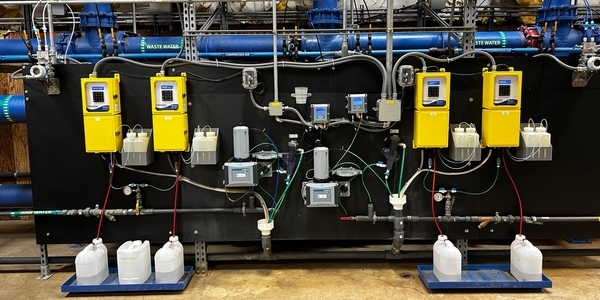Filtration Process Benefits from Robust, Low-Maintenance Analyzers
Published on by Marcus Miller, Digital Marketing Manager at In-Situ in Case Studies

Filtration Process Benefits from Robust, Low-Maintenance Analyzers
Overview
Analyzers monitoring iron and manganese levels at influent and effluent freed time for Junction City staff and enabled more informed decisions about well sequencing, filter cleaning and other key elements of their filtration process.
Challenge
Though iron and manganese are classified as secondary contaminants in the U.S., wells in Junction City–the main source of the city’s water supply–held enough of these elements that sediment buildup became a problem for the distribution system. The municipality regularly sent crews out to flush the sediment in specific neighborhoods, a time-consuming and unpleasant process for residents and utility personnel alike.
“We’re a small crew, so every minute counts,” says Jason Haddy, Water Treatment Operator with the Junction City Public Works Department (JCPW). “The more time the utility crew spent doing that, the more it took away time from other projects.”
In 2014, Junction City constructed a water treatment facility to improve drinking water quality and protect infrastructure from sediment buildup. But the equipment installed in the plant demanded much of the crew’s time.
“We had a lot of problems,” says Haddy. “We were troubleshooting all the time. And it could need anything from a simple fix to something that would take 45 minutes to an hour.”
The crew depended on efficient time management to keep up with their workload. Frequent troubleshooting requirements created additional scheduling pressures for the small team. While operators performed troubleshooting and maintenance routines, the equipment couldn’t collect data. This lack of information further frustrated operators.
What’s more, the manufacturer was based abroad, making it difficult to get replacement parts. “Anytime we needed major parts or chemicals, we had to make sure we ordered that stuff months in advance because it had to go through customs,” says Haddy. “It was not an ideal situation.”
All told, Junction City knew they needed a more robust solution to monitor the filtration process and balance their workload. “We all wear so many different hats around here, time we don’t have to spend troubleshooting is money in our pockets,” Haddy says.
Solution
JCPW heard about ChemScan analyzers from colleagues in wastewater treatment. Three years ago, they purchased two ChemScan mini Analyzers to monitor iron and two to monitor manganese. They installed one of each at the points of influent and effluent.
The difference has been night and day. “As long as we’re doing the basic maintenance, it’s one of the last things we have to worry about,” says Haddy.
The analyzers help Haddy confirm the overall effectiveness of the filtration process, but they also allow him to arrange well sequencing to minimize iron and manganese coming into the plant and reduce stress on the aquifer.
The analyzers’ water quality data gives Haddy an idea of where in the water column the influent comes from. If the plant receives a sudden increase in iron, it might indicate they need to turn down pumping rates. “We’ll reduce the gallons per minute that we’re pulling from our wells, so that it allows that water to catch up and we’re getting a better quality of water,” Haddy says.
Reliable data has increased Junction City’s understanding of different well dynamics in the area. “We have some wells that have sand issues, some wells that have higher manganese content or higher iron content and we have to keep an eye on that,” Haddy says.
Data from the analyzers allows operators to calibrate the proportion of water they’re taking from each well to ensure the best water quality. “How do we want those wells to operate in sequence?” Haddy asks. The analyzers enable him to better answer this question.
And they’ve made it easier to adjust to seasonal fluctuations in water chemistry and demand. “Our town is increasing like a lot of other towns,” Haddy says. “When I first moved here 30 years ago, we were a town of about 2,200 people. Now we’re over 7,000 people–just keeping up with the water demand during the summer months is a big issue.”
While the city removed water quality instrumentation from the wells after completing construction of the plant, Junction City still measures water level to make sure they’re not drawing down the aquifer.
Results
JCPW recently changed the order of the filtration process to...
READ MORE
Taxonomy
- Water Treatment Design
- Produced Water Treatment
- Drinking Water Treatment
- Household Water Treatment
- Water Treatment & Control
- Industrial Water Treatment
- Waste Water Treatments
- Water Treatment Solutions
- Water Monitoring
- Water Monitoring
- Drinking Water Managment
- Drinking Water
- Water Systems Monitoring
- Water Quality Monitoring
- water treatment
- Water Treatment Systems
- Water Treatment & Control
- Water & Wastewater Treatment
- Waste Water Treatment
- Water Quality Monitoring
- Water Treatment Plant Design
- Comprehensive Water Treatment
- Water Treatment Systems
- waste water treatment
- Water treatment
- Water Treatment
- Water Treatment Enterprise Information Data Management
- Technical Director for company selling water and waste water treatment equipment
- Utility Boiler and Cooling Water Treatment
- Industrial Water Treatment Consulting
- Water treatment
- Water treatment
- water treatment
- High Performance Equipment for Waste Water Treatment
- Water treatment systems manager
- Waste water treatment plant operator
- MBBR for water treatment
- MBBR for Water Treatment
- Water, Waste Water Chemical & Treatment
- water treatment operator
- Water and wastewater treatment
- Drinking Water Management
- Water Treatment Plant Products
- Ultra Fine Bubbles For Water Treatment
- Water Treatment Chemicals Sales & Services
- Water Treatment UV / Ozone
- Water Treatment Equip
- Armature Water Treatment Solutions Wannabe